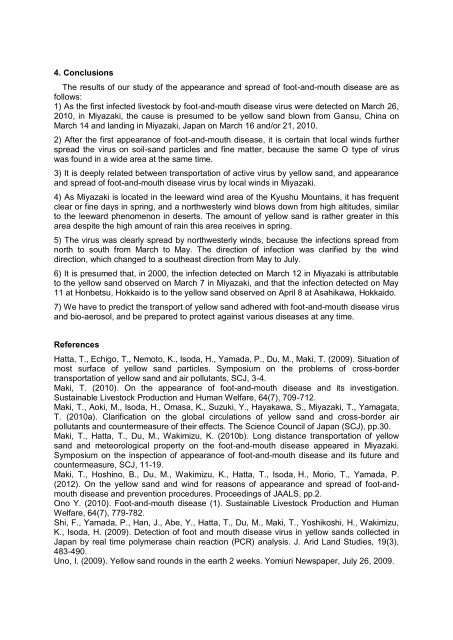Manuscript Preparation Guidelines for the CIGR-Ageng Conference ...
Manuscript Preparation Guidelines for the CIGR-Ageng Conference ...
Manuscript Preparation Guidelines for the CIGR-Ageng Conference ...
Create successful ePaper yourself
Turn your PDF publications into a flip-book with our unique Google optimized e-Paper software.
4. ConclusionsThe results of our study of <strong>the</strong> appearance and spread of foot-and-mouth disease are asfollows:1) As <strong>the</strong> first infected livestock by foot-and-mouth disease virus were detected on March 26,2010, in Miyazaki, <strong>the</strong> cause is presumed to be yellow sand blown from Gansu, China onMarch 14 and landing in Miyazaki, Japan on March 16 and/or 21, 2010.2) After <strong>the</strong> first appearance of foot-and-mouth disease, it is certain that local winds fur<strong>the</strong>rspread <strong>the</strong> virus on soil-sand particles and fine matter, because <strong>the</strong> same O type of viruswas found in a wide area at <strong>the</strong> same time.3) It is deeply related between transportation of active virus by yellow sand, and appearanceand spread of foot-and-mouth disease virus by local winds in Miyazaki.4) As Miyazaki is located in <strong>the</strong> leeward wind area of <strong>the</strong> Kyushu Mountains, it has frequentclear or fine days in spring, and a northwesterly wind blows down from high altitudes, similarto <strong>the</strong> leeward phenomenon in deserts. The amount of yellow sand is ra<strong>the</strong>r greater in thisarea despite <strong>the</strong> high amount of rain this area receives in spring.5) The virus was clearly spread by northwesterly winds, because <strong>the</strong> infections spread fromnorth to south from March to May. The direction of infection was clarified by <strong>the</strong> winddirection, which changed to a sou<strong>the</strong>ast direction from May to July.6) It is presumed that, in 2000, <strong>the</strong> infection detected on March 12 in Miyazaki is attributableto <strong>the</strong> yellow sand observed on March 7 in Miyazaki, and that <strong>the</strong> infection detected on May11 at Honbetsu, Hokkaido is to <strong>the</strong> yellow sand observed on April 8 at Asahikawa, Hokkaido.7) We have to predict <strong>the</strong> transport of yellow sand adhered with foot-and-mouth disease virusand bio-aerosol, and be prepared to protect against various diseases at any time.ReferencesHatta, T., Echigo, T., Nemoto, K., Isoda, H., Yamada, P., Du, M., Maki, T. (2009). Situation ofmost surface of yellow sand particles. Symposium on <strong>the</strong> problems of cross-bordertransportation of yellow sand and air pollutants, SCJ, 3-4.Maki, T. (2010). On <strong>the</strong> appearance of foot-and-mouth disease and its investigation.Sustainable Livestock Production and Human Welfare, 64(7), 709-712.Maki, T., Aoki, M., Isoda, H., Omasa, K., Suzuki, Y., Hayakawa, S., Miyazaki, T., Yamagata,T. (2010a). Clarification on <strong>the</strong> global circulations of yellow sand and cross-border airpollutants and countermeasure of <strong>the</strong>ir effects. The Science Council of Japan (SCJ), pp.30.Maki, T., Hatta, T., Du, M., Wakimizu, K. (2010b). Long distance transportation of yellowsand and meteorological property on <strong>the</strong> foot-and-mouth disease appeared in Miyazaki.Symposium on <strong>the</strong> inspection of appearance of foot-and-mouth disease and its future andcountermeasure, SCJ, 11-19.Maki, T., Hoshino, B., Du, M., Wakimizu, K., Hatta, T., Isoda, H., Morio, T., Yamada, P.(2012). On <strong>the</strong> yellow sand and wind <strong>for</strong> reasons of appearance and spread of foot-andmouthdisease and prevention procedures. Proceedings of JAALS, pp.2.Ono Y. (2010). Foot-and-mouth disease (1). Sustainable Livestock Production and HumanWelfare, 64(7), 779-782.Shi, F., Yamada, P., Han, J., Abe, Y., Hatta, T., Du, M., Maki, T., Yoshikoshi, H., Wakimizu,K., Isoda, H. (2009). Detection of foot and mouth disease virus in yellow sands collected inJapan by real time polymerase chain reaction (PCR) analysis. J. Arid Land Studies, 19(3),483-490.Uno, I. (2009). Yellow sand rounds in <strong>the</strong> earth 2 weeks. Yomiuri Newspaper, July 26, 2009.
















